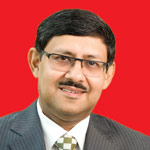For India to ensure almost full employment, all segments of the economy should move in tandem
The economic survey for 2016-17 pointed out that India’s young working-age population is likely to peak in 2020, adding, “The growth boost from the demographic dividend is likely to peak within the next five years, as India’s share of working-age population plateaus.”
With a population of roughly 1.25 billion, of which around 50% is below the age group of 25 years and about two thirds is below the age of 35 years, India’s ‘young’ population alone, (i.e. those below the age of 35 years) is more than double the total population of the US and roughly 100 million more than the population of all the G7 countries combined!
This ‘demographic dividend’, as it is popularly called, presents an immense opportunity for our country to harness; the productivity of this young work force could be converted into a powerful engine for economic growth. According to a recent Regional Human Development Report (Asia-Pacific) by the United Nations Development Program (UNDP), “When countries have a greater share of people who can work, save and pay taxes, they have the potential to transform their economies and power investments in healthcare, education and other building blocks of future prosperity.”
However, the report also revealed that India’s working-age population increased by 300 million in the 22 year period between 1991 and 2013, while the number of employed people increased by only 140 million. This implies that the economy absorbed less than half the new entrants into the labour market. At the same time, in China, the working-age population increased by 241 million over the same 22 year period, while the number of jobs grew by 144 million. The study concluded, “A wider gap in India than China suggests a more limited capacity to generate employment — a serious challenge given the continued expansion of the workforce in India over the next 35 years.”
The predicament that India faces at present is that although we have the largest number of young people, a large portion of them is either totally unemployed or only partially employed, that too primarily in the unorganized sector. Inadequate ‘jobs’ and, as a result, a lack of opportunities for income generation will not only result in a lost opportunity in terms of GDP growth but could potentially cause social unrest.
Encouraging grass-root entrepreneurship could well be the best route to bridging the employment gap. The Medium, Small and Micro Enterprises (MSME) sector has been the backbone of the Indian economy, often even protecting it from global economic shocks and their fallout. The CII estimates that this segment has around 36.1 million units throughout the geographical expanse of the country and has consistently maintained a growth rate of over 10%. It contributes around 6.11% of the manufacturing GDP and 24.63% of the GDP from service activities as well as 33.4% of India’s manufacturing output. It provides employment to around 120 million people and accounts for around 45% of the overall exports from India. Most importantly, about 20% of the MSMEs is based out of rural areas; this underscores the importance of such enterprises in promoting sustainable and inclusive development as well as generating large scale employment, especially in the rural areas.
The Narendra Modi government appears to be following a multi-pronged approach to making the most of the abundant human resource pool that India is uniquely endowed with. Most of the measures – be encouraging start-ups or skilling of youth or availability of funding to the MSME sector – all appear to be aimed at encouraging the youth to set up their own enterprises. At a recently held gathering of prominent Indian start-up entrepreneurs called the ‘Champions of Change’, organized by federal policy think tank NITI Aayog, the prime minister expressed the government’s intention to work closely with young entrepreneurs in developing a roadmap for growth.
While one cannot wish away the importance of large manufacturing as well as infrastructure projects for generation of employment, we shouldn’t lose sight of the power of MSME in creating a virtual cycle of prosperity. The Government is keen to use MSME for employment generation and provide necessary support for this purpose. However, for India to achieve double digit growth and ensure full or almost full employment, all segments of the economy should move in tandem.





















